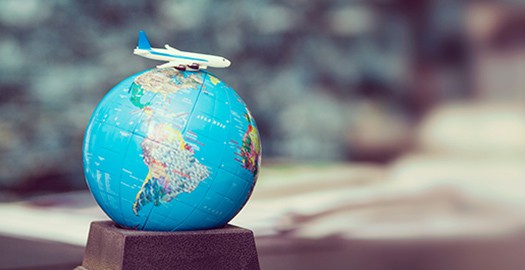Every year the travel industry is marked with significant changes. In 2019 it experienced many trends that left a trace. Words such as experiences, digitalization, and behaviour were popping across all segments and raising awareness to the importance of these factors – separate and combined.
Social media was another hot topic. The high resonance it promotes with users, and its powerful advertising functions have put destinations on the spotlight. The consequences of overtourism are one of the trends that will remain present in 2020. However, the rising concept of sustainability in all its forms may be the solution to such problems.
Finally, the large amount of technological innovation that emerged during the past year resulted in a signaling effect for companies. With such dynamism in the digital environment, travel companies had to learn to improve their online presence and strategize for the future.
Top Travel Trends 2020 per industry
According to Statista, online travel sales worldwide are projected to surpass the 800 billion dollar mark in 2020. With that, it is not difficult to predict that digitalization will remain present in the industry. The focus will turn to the smart automatization of processes, integrating all types of technological intelligence available. Additionally, the ever-growing need for improving digital navigation and responsiveness of digital channels will call for urgent changes as users will be more likely to ignore those who don’t comply with the rules.
Airlines & Airports
The airport experience is one of the main pains for travellers. The many obstacles faced when it comes to check-in, drop-offs, passport control, and boarding result in a negative perception and, consequently, a harmed customer experience. To tackle this problem, airlines and airports have started testing the use of biometrics to smooth the journey. This technology would enable passengers to travel “hands-free”, without worrying about travel documents of any kind, thus making biometrics one of the top travel trends in 2020.

Even more likely to happen at the beginning of the year is the implementation of bots on digital channels. Although some carriers have already incorporated bots to assist users with their inquiries, the outcome of the interactions is not always successful. The attention to perfecting the responses generated by the bots is much needed and should be on the top of airlines’ digital priorities.
Hospitality
Experiences are important for travelers, and it is due to this preference that hotels are facing some changes in booking. Skift reported that 67% of travelers would prefer to spend on experiences rather than on a better hotel room. With this in mind, hotels also need to switch their focus and attract guests through other means.
One of the most significant advantages a hotel may have is its location. More than general experiences, guests seek for cultural/local activities that are unique to the destination. Highlighting such experiences that are conveniently close to the hotel may be a better way to convince guests to book a room. This ‘local mini guide’ can gather all sorts of events, from a food tasting to a concert or local flea market.
Sustainability is also one of the travel trends 2020 that has been pushing hospitality players to adapt their practices. Once again, customers are shaping the industry through their preferences, which are now forcing companies to develop social responsibility and environmental moves. Actions to reduce plastic and save water, for example, are what is expected from hotels.
Finally, the efforts to increase direct bookings are making hotels heavily invest in strengthening the brand image and perfecting the booking engines. Online strategies such as email and social media marketing are tools that these players will continue to use to generate loyalty and retain customers within the hotel brand’ territory – throughout the entire purchase journey.
DMOs
It should be old news, but the mobile-first rule will not be disappearing any time soon. The talk goes beyond responsive websites, and into mobile apps! Destinations need to interact with visitors and citizens on the go, and there is no better way to do so than through mobile solutions. Allowing travellers to have easy access to useful tools such as a trip planner like for instance, like one from Buenos Aires Tourism Board, is not only beneficial for DMOs to promote their business and experiences but also to add value to the traveller’s journey.
One of the drivers of the switch to mobile is social media. The impact sharing platforms have on creating a strong and valuable brand is tremendous, and destinations are no exceptions to the rule. Destination marketing strategies are adding social media along with customer experience to the center of the circle, with all actions surrounding these two main points. Whether it is through influencers, audiovisual material, or merely being present, there is no way to avoid it. Moreover, to tackle the overtourism issue, destinations are more likely to make good use of this powerful media to highlight other hidden gems in order to deviate tourist crowds.

OTAs
Since its existence, OTAs battle to achieve relevance over individual brand channels. The concept of an online hub to plan a trip is, of course, attractive, but it does not do the trick. But there are two travel trends in 2020 that may help OTAs nail it.
For 2020 OTAs will have to seek exclusive and unique partnerships to increase brand awareness. The secret will be in the quality and not quantity. Having just a few partners that can act as strong differentiators will be easier to manage and have a higher impact on the brand than having plenty with the same value proposition. Users are browsing through almost identical deals in the hope of finding one that offers something different and unexpected.
Another strategy that will be powerful is the adoption of dynamic pricing. Disney is one example of a company that has already adopted the concept of its resorts and parks. Applying the dynamic pricing strategy allows OTAs – almost instantly – to respond to online demand. Stepping away from the seasonal price variance and moving to a daily reaction. Users are more attracted by such strategy, and OTAs more likely to convert through the smart reduction of prices when needed. As for competition, those with dynamic pricing will present a threat by making more attractive deals.
What to expect from us in 2020?
Smartvel closely observes the changes in the industry in order to evolve at a similar pace. In 2019 the company innovated its solutions, and the forecast for 2020 remains the same; however, the speed to which changes are introduced is expected to increase as the industry itself is running at a faster pace each day.
How is Smartvel responding to the travel trends 2020? Sustainability – as already mentioned – will remain an active topic and will translate to Smartvel’s solution as a more extensive catalog of eco-friendly experiences. On the technology side, work will be done to improve accessibility and inverse usability. Additionally, attention will be paid to the user behaviour data, allowing clients to track patterns and behaviour of logged users on their platform.





